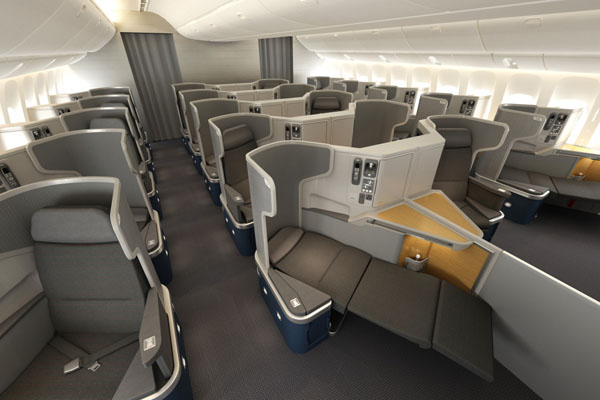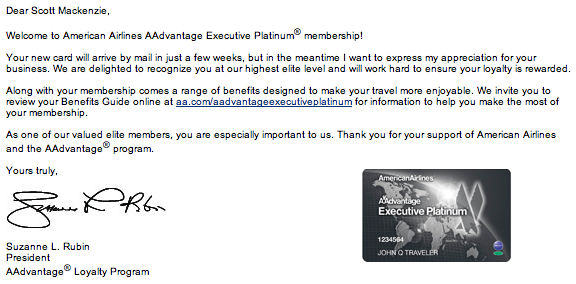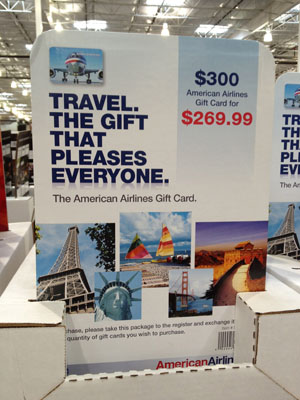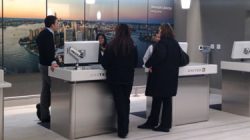I write this post having not flown on American in well over eight years. The few miles I have were earned through an Alaska Airlines codeshare and an AAdvantage Shopping portal mistake involving Verizon Wireless. My lifetime travel is only 24,000 miles, and *gasp* I’ve allowed some of those to expire so that I only have about 12,000 RDM today. And yet… American has become desperate enough (or wily enough) to offer complimentary status matches to United elites. This includes matches to their top-tier Executive Platinum status for those with Premier 1K status at United, and normally both companies protect their top-tier from status matches or even challenges.
Megan and I submitted our match requests a week ago, and although I didn’t get any notification, I logged on Tuesday morning and noticed that my status had been updated along with eight eVIP systemwide upgrades. I wasn’t sure at first I would get these upgrades as a new EXP even though I hadn’t actually done any of the flying, so I’m pretty happy. The following day, I got an email welcoming me to the program.
I’m pretty psyched about it, too, because I can use them on any fare–unlike the United systemwide upgrades that can only be used on mid-priced economy fares or higher. Why spend 50% more to be put on a waitlist? American has also been working to extend a few of its elite benefits to Alaska planes, which is good because nearly all flights out of Seattle are operated by Alaska, not American (e.g., SEA-SFO) or Alaska just has more convenient direct routes (e.g., SEA-LAS). So although I haven’t flown American/Alaska lately, I am likely to do so soon and may even try to keep my top-tier status with both airlines.
It bears asking how I think the two carriers measure up against each other. I have no intention of dumping my 1K status, which has worked to my benefit for the most part. I also feel that American has been overly generous with its EQM and status matches so that if I did jump ship, I might find my benefits diluted next year. For now I’m just a lucky beneficiary who had nothing to lose. But that still doesn’t mean United is perfect or that American can be completely ruled out. So here are my impressions about how the two top-tiers stack up. The Points Guy already did a similar comparison last year, although I feel it might confuse the issue at hand by including US Airways and Delta. You can also read more at the websites for American AAdvantage or United MileagePlus.
Domestic Upgrades
United places me second in line for domestic upgrades after its Global Services members, and I usually get upgraded when flying alone even on G fares. American will give me complimentary upgrades, too, although I believe I will be the first and only group that gets them. There is an invite-only Concierge Key service, but my understanding is that it applies mostly to service on the ground. And while lower tiers also get free upgrades on full-fare tickets, the same is true on United. I’d expect nothing less.
Some people complain that all the GS members on United make 1Ks second class passengers, but I’ve never felt that. GS is still a smaller group than 1K, and I would argue that since most of them got where they are by buying expensive fares, they would probably get priority on upgrades even if they were still part of the 1K pool without a GS bump.
Where things get problematic is that American does not provide companion upgrades, and I very much appreciate that United treats Megan with the same status I have. Sometimes it means we miss an upgrade because people traveling alone get bumped up before us, but that’s okay. With American, I’ll have to buy her some 500-mile upgrade certificates at a cost of $30 to $150 per domestic flight.
International Upgrades
This is where American really shines. They don’t make the upgrades impossible to use. If you want to upgrade your flight, use an upgrade. And you’ve got eight of them! That’s two round trips for Megan and I. United gives me only six that are a pain to use, and from recent reports seem to be difficult to apply as upgrade space is often lacking. United does provide four regional upgrades, while American does not, but I think the flexible systemwide upgrades are more important.
Catering and On-Board Product
United is working to improve its food. It really is. Continental had great catering so I’m told. But during the merger United let it fall even further and is only now catching up, restoring some features even as it adds new ones. American, however, keeps coming up with new things. They’ve had ice cream sundaes long before United, they never got rid of hot nuts, and the main courses I read about–even on domestic routes–make my mouth water. With United I’m just grateful for any food in first class; in economy you might not get anything at all on long routes like New York to Honolulu. Clearly American wins this one.
Both American and United offer flat bed seats in first and business class, though business class is in a state of flux. I’m not exactly sure of the status of United’s flat bed business class roll-out, but I know it’s near completion whereas American has only recently announced a revamp of its fleet that is expected to take years.

American has extensive WiFi on its international and domestic routes, while United has barely any, but then again I can usually tolerate several hours without Internet access. American is also working to improve the comfort of its business class seats, including actual duvets and a spiff new seat layout. I’m not sure what United is doing, but I know that some report the new business class seats are too narrow and that the rear-facing rows freak people out. (It certainly freaked me out when I was sitting in coach staring at business class for 10 hours. I don’t know how I would feel if I were the guy staring back.)
However–and this is important–I love United’s EconomyPlus seats. American’s extra legroom product is far more limited, and should you get stuck in standard economy, some widebody planes will have 10 seats across instead of United’s nine. Since I still sit in coach often enough, these differences matter a lot.
Customer Service
I hear lots of good things about American. I also hear lots of good things about United’s 1K desk …at least I used to. I think the merger is still leaving a few things up in the air. Personally, I don’t complain that much or have complicated problems, so I’ve been satisfied (I may whine on my blog, but in real life I’m quite passive). To be fair, I can’t really weigh one way or the other on this issue.
Route Networks and Alliance Partners
Finding award space, in my opinion, is much easier on United since they include all partners in their online search engine. Yes, it’s a little buggy, but nothing like Delta. American’s partners seem to have better availability than United’s on some routes, but I think this is all partner-specific and not United or American’s fault. I’m of the opinion that the quality of these partners’ products is more or less the same. United has some very, very good partners in the Star Alliance like Swiss and Singapore, but American has some good ones, too. I don’t see any reason to make this issue a dividing one.
As for the actual destinations, United is huge and goes to many more places. American doesn’t, but it has its regional strengths. I think American realizes it can rely on its partners for many of its holes, and while that may work in some ways, it does have drawbacks as far as the use of systemwide upgrades is concerned. I like the idea of having top-tier status in both programs partly because each airline focuses on different routes. Connections are great when you want to rack up extra miles, but sometimes you really just don’t have the time.
Cost
This is the big one that determines whether it’s feasible for me to maintain my status with both carriers. It turns out that American is very affordable if you play your cards right. United provides almost no discount opportunities and has even gotten tight with compensation. American, however, regularly offers discount codes, and you can even find public conference codes for 5-10% off if you look around on the Internet. Costco sells $300 American Airlines gift cards for only $270. You could even buy that gift card with an Amex prepaid card from Office Depot that you purchased with a Chase Ink Bold for 5X Ultimate Rewards points. Finally, there are also lots of 2X RDM/EQM promos (at least lately) to help you reach your goals without flying as much.
If you value the UR points at 2 cents, then combining the Costco and Ink Bold deals would earn you a 20% discount on all American Airlines travel. Combine it with a conference or other discount code, and you can turn that into a 25-30% discount on most travel.
Conclusion
The financials of being an American elite are great, particularly for upgrading international travel or when I really must have a direct domestic flight. I just still can’t see myself flying them regularly with a companion, and most of my travel continues to be to United hubs like San Francisco, Houston, and Washington, DC. It will ultimately boil down to time. I can see myself racking up 50K EQM or more through upgraded international trips with Megan, but beyond that, I may have to do some serious mileage running to keep up the status for another year. And that is where the DEQM promos will start to come in handy. Let’s hope they stick around through fall and winter!







